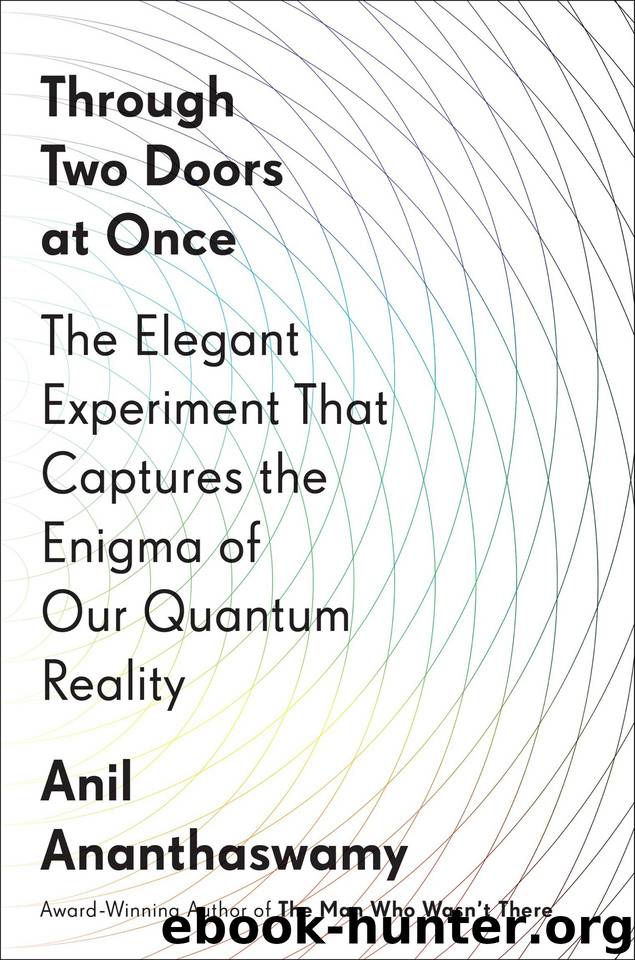Through Two Doors at Once: The Elegant Experiment That Captures the Enigma of Our Quantum Reality by Ananthaswamy Anil

Author:Ananthaswamy, Anil [Ananthaswamy, Anil]
Language: eng
Format: epub
Publisher: Penguin Publishing Group
Published: 2018-08-07T07:00:00+00:00
That’s because a traditional “strong” measurement, which ostensibly collapses the wavefunction of the thing being measured, destroys the coherent superposition of the particle. The particle is irrevocably disturbed, even destroyed, by a strong measurement.
So, finding a particle’s possible trajectory using such measurements is an impossibility. Think of how different this is from determining the path of, say, cars on a highway. If you put cameras every 100 meters to record the passing of cars, the information from these cameras can be used to reconstruct the trajectories of the cars moving past. But if you try to do this for photons or electrons, it doesn’t work. Each strong measurement that tries to find out the location of a particle gives the particle such a kick that it no longer goes where it would have gone had there been no measurement. There’s really no way to measure trajectories of particles using strong measurements without altering them.
In 1988, Yakir Aharonov (one of Bohm’s students), along with David Albert and Lev Vaidman, came up with a theory of what they called “weak measurements.” What if one doesn’t try to find out the precise value of some property of a quantum system but, rather, probes it ever so gently, so as to not disturb the particle, allowing it to continue on its trajectory as if nothing happened? It turns out that the outcome of any such individual measurement is rather useless. The uncertainty in the measurement means the result could be widely off the mark. But Aharonov and colleagues showed that if you do such measurements on a large ensemble of identically prepared particles, then although each measurement alone isn’t revelatory, taken together they are. The team argued that the average value of all measurements—say, in this case, of a particle’s position—is an indication of its average position.
There’s plenty of controversy about whether this average value is indeed giving you any relevant information about a particle’s property. But some physicists saw in weak measurements a way to measure particle trajectories. In 2007, Howard Wiseman of Griffith University in Brisbane, Australia, showed that you could use weak measurements to seemingly measure the positions and momenta of particles moving through a double-slit apparatus. The idea is simple: you take hundreds of thousands or even millions of identically prepared particles and send them through the double slit one by one, and you perform weak measurements, say, at different locations between the double slit and the screen where the interference is observed. These weak measurements can then be used to reconstruct the trajectories of particles traversing the apparatus. “ It must be emphasized,” wrote Wiseman, “that the technique of measuring weak values does not allow an experimenter . . . to follow the path of an individual particle.” That would be a violation of the rules of quantum mechanics. Nonetheless, one could, in principle, reconstruct average trajectories.
Until Wiseman’s paper, the idea of measuring trajectories had been anathema, but his work changed minds. Aephraim Steinberg’s team took on the task. As always with such experiments, it involved some very sophisticated optics.
Download
This site does not store any files on its server. We only index and link to content provided by other sites. Please contact the content providers to delete copyright contents if any and email us, we'll remove relevant links or contents immediately.
The Complete Stick Figure Physics Tutorials by Allen Sarah(7307)
Secrets of Antigravity Propulsion: Tesla, UFOs, and Classified Aerospace Technology by Ph.D. Paul A. Laviolette(5309)
Thing Explainer by Randall Munroe(3877)
The River of Consciousness by Oliver Sacks(3540)
The Order of Time by Carlo Rovelli(3145)
How To by Randall Munroe(3035)
A Brief History of Time by Stephen Hawking(2961)
I Live in the Future & Here's How It Works by Nick Bilton(2935)
The Great Unknown by Marcus du Sautoy(2648)
What If?: Serious Scientific Answers to Absurd Hypothetical Questions by Randall Munroe(2637)
Midnight in Chernobyl by Adam Higginbotham(2483)
Blockchain: Ultimate Step By Step Guide To Understanding Blockchain Technology, Bitcoin Creation, and the future of Money (Novice to Expert) by Keizer Söze(2449)
Networks: An Introduction by Newman Mark(2360)
The Meaning of it All by Richard Feynman(2300)
Easy Electronics by Charles Platt(2282)
The Tao of Physics by Fritjof Capra(2231)
Midnight in Chernobyl: The Untold Story of the World's Greatest Nuclear Disaster by Adam Higginbotham(2177)
When by Daniel H Pink(2083)
Introducing Relativity by Bruce Bassett(2080)
